While most of us are aware of how important creating search engine optimized (SEO) content is, only a rare few individuals on Hive actually do it. I attribute this lack of participation to the absence of definitive information and concrete incentive for users to partake in this fairly difficult task. Both of which I'd like to revamp with the completion of the Ultimate Hive SEO guide and the planned incentive structure I've got in mind for when the guide is finished. A clear-cut set of rules and guidelines on exactly how to write SEO-friendly content that ranks high across all search engines, and an innovative incentive model to encourage participation.
For starters, let's look into the actions we can take to create more optimized content.
Essential SEO tips for Hive content creators

Writing regular, generic articles is easy and anyone can do it, but crafting high-quality SEO-friendly content is a whole nother game. It requires laser-sharp focus and dedicated effort toward producing the right kind of content that readers will actually search for. It won't come easy at first, especially at the beginning but as soon as you pick up the basics and get some practice, you'll quickly get the hang of it. Your readers will greatly appreciate the additional effort and the reach of your publications will go through the roof.
In order to write in a way that's both reader and browser-friendly, we need to follow a set of rules and principles to go by when conceiving and materializing compelling SEO articles. While I'm no expert, I've been doing a lot of research on the topic.
Here is what I've found out.
When writing with the goal of creating SEO content we must:
#1 Be strategic about our content
#2 Create evergreen, comprehensive, and useful content
#3 Make good use of keywords
#4 Write eye-catching headlines
#5 Structure and style our content to increase readability
While there may be many other advanced techniques for boosting SEO, in order to attempt to salvage the length and complexity of this article, I've decided to distill it into these five. This should be more than enough to get you going and increase your rank. If you decide to play the SEO game wisely, that is.
#1 Be strategic about your content

Writing good SEO articles is going to be a lot different than your regular "Out in the park with the dog" or "Check out this new cool thing I got" generalized posts.
In order to pull in a lot of eyeballs, your content must be fulfilling a burning desire in the mind of your target audience. A great piece of content will not only satisfy this desire for information but will also present it in an enjoyable and easily digestible format. It will be factual, informative, and straightforward, with no beating around the bush. Outstanding SEO content will always be remarkably helpful and it will meticously cover a specific topic or solve a certain problem.
When thinking about your next killer article a good way to start is by answering the following questions:
- What topic do I want to cover?
- What questions do I want to answer?
- What specific problem is my article going to solve for my readers?
- What type of format should I use to best relay the message?
- What style should I write in?
- What's going to make my article unique?
By simply going through this mental gymnastics, you'll quickly get that lightbulb moment and be able to pinpoint exactly what to write about and how to present your knowledge in the best way possible.
What topic do I want to cover?
What questions do I want to answer?
What specific problem is my article solving for my readers?
Take this post for an example.
It answers a specific question: "How to write more SEO-friendly content?" and it solves a specific problem: "low rank on search engines". As such, it has a higher probability of being directly searched for and that's the goal of any good SEO article. To be directly searched for by potential prospects with a problem that your article solves.
For optimal results, it's important to identify and address a specific topic, question, or problem you want to solve for your readers. Pick one and stick to it. After all, the goal is to create specialized, SEO-friendly content, not generalized and sometimes even personal-diary like articles which can be interesting at times but they are nowhere near ideal for SEO.
To succeed with SEO and content marketing, it's crucial to write about topics and burning issues that your target audience actually cares about. Without presenting specific information that they search for is more often than not, going to result in your articles being obscured by vast amounts of more well-thought-out and optimized, articles.
That's definitely not a place you want to be after spending so much time on time creating first-rate content.
But what if your creative juices ran dry and you can't figure out what to write about?
Here are a few ways to find topics for your next article.
- Use Q&A sites such as Quora and Reddit to manually find questions your target audience searches for online
This is an easy one.
Hop on your preferred site, locate the community/tag/section constituting your target audience and start clicking. Soon, you will find yourself a wealth of inspiration. Try to locating questions that people have already shown a big interest in (look for high engagement) and provide a unique answer which hasn't been brought up so far.
Additionally, you can post a TLDR accompanied by a link to your full article as a response to the question on the platform it was originally published on for some extra visibility/exposure.
- Simply browse the web for a specific question/keyword/topic/interest/niche community and see what pops up
I hope this is self-explanatory.
- Visit related forums, news-outlets, and groups/pages on your preferred social media platforms
Jump on bitcointalk, 4chan, Facebook, Twitter, Youtube, Pinterest and click away until you find something interesting and worthwhile to write about. This is often where you'll find the most inspiration as going through writings related to the topic you want to cover will get your neurons firing and creative juices flowing in no time.
- Use free tools such as UberSuggest, BuzzSumo, AnswerThePublic, and Google Trends
These are a treasure-trove of ideas.
Just type in a keyword and instantly you're going to find yourself with countless ideas for your next article. They are so easy to use that I won't go into more detail. Just know that you are only a few clicks away from your discovering topics that people actually search for!
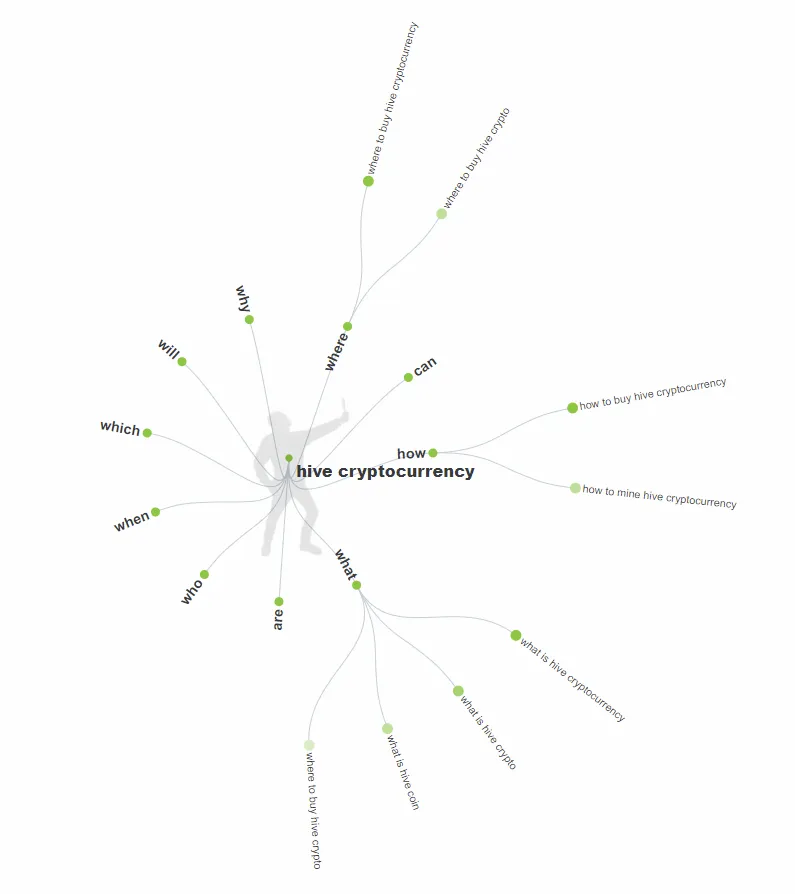
For even more content-discovery tools and their brief explanation visit this article.
What style should I write in?
What's going to make my article unique?
What format should I use to best relay the message?
Once you've established clear ground by finding a topic to write about, question to answer and/or problem to solve the next step is to decide what type of content format to use to most efficiently relay the message you are trying to get across. Some topics would be covered better in a video than text, while others work best with image format like a meme or infographic, and for some topics, it's best to not over-complicate things and just stick to the good old fashioned written content.
Provided that you've chosen to write your thoughts out on this digital storyboard, the next step is to decide what style to write in. It will greatly depend on the topic and target audience. If you are writing a tech review, you're obviously going to use a more technical, data-oriented tone. On the other hand, if you're writing for a younger audience and the topic isn't as technical as tech review, you can opt for a more friendly, humorous, and conversational tone.
Finally, once you've got all this figured out it's time to find an edge that will make your article unique. Your competitors have likely written similar articles, which means your potential readers need your article to be unique — or, at least, different. To make your content worth consuming it's paramount to provide a unique value proposition which readers can't find elsewhere.
Create more unique content by:
- Digging deeper
- Expanding further
- Editing to perfection
- Using multiple resources
- Including an interesting twist
- Offering new insights/perspectives
- Using a unique content structure/style
- Providing personal experience if possible
- Using your own logic to explain things how you understand them
Sprinkle some of that magic on top to make your content stand out from the crowd.
#2 Create evergreen, comprehensive, and useful content

Evergreen content passes the test of time with an A+ remaining relevant forever. It has long-lasting value. Just like an evergreen tree that has leaves year-round, evergreen content always has a use. It’s a post that readers can reference for years to come because the information will always be true, relevant, and valuable.
Evergreen content include:
Top tips
Testimonials
Product reviews
How-to tutorials
Encyclopedic information
Frequently asked questions
In contrast to evergreen below are some formats with an expiration date:
Seasonal content (Christmas, BlackFriday, Women’s Day, Mother’s Day, Concerts, etc. )
Trending topics (these tend to die off pretty fast)
News articles
Creating evergreen articles is crucial as it has a long shelf life and it keeps pulling in views throughout the years. Unlike a seasonal blog post that has a traffic spike right after publishing which quickly dies down, evergreen articles grow traffic and continue to bring in views over long periods of time.
Tips for writing evergreen:
Choose a precise topic
and stick to it.Aim at beginners
because they constitute the largest amount (%-wise) of your target audience.Be very specific and straight to the point
because no one likes ambiguity.Choose the right keywords (will be explained in a future article)
if you want to rank high on search engines.Present your knowledge and authority
to build trust and credibility and establish a sence of expertise.Choose an easy-to-follow structure and style (explained down below (#5))
to reduce cognitive-load and ensure a free-flowing experience for your readers.Avoid overly technical language
to avoid boring your readers to death.Revisit your posts to update them if neccessary
or your evergreen articles will quickly become outdated and deciduous.
By going through a couple of examples you'll soon realize how all highly-ranked evergreen articles follow this exact modus-operandi. Methodically structured and styled, based on factual and verifiable information, straight to the point, geared for beginners, explained in a very casual and non-overly technical language that anyone can understand.
That's evergreen content in a nutshell.
Examples of comprehensive, useful, and evergreen articles:
Open them up and notice a few things:
Styling
Paragraph length
Information layout and clarity
Use of headings and images
These articles are not only evergreen but also high-ranking (top few spots on Google) meaning that their search engine optimization is spot-on. They are prime examples of well-optimized articles. Read through them a couple of times to get a grip on how a good SEO article should look like.
Notice how neatly information is laid out to make for an easier read?
That's just one component of a great SEO piece (out of many) that you'll learn to replicate by following the tips from this article and the Ultimate Hive SEO Guide.
For more information about how to write evergreen content visit:
#3 Make good use of keywords

Given that this topic will soon get an article of its own I'll just scratch the surface today. In a dedicated article, I'll further expand upon what's mentioned here and update the information under this section with the full keyword guide. By now you are most likely aware of how important keywords are for ranking higher on search engines so I won't dwell upon that.
We'll jump straight into how to utilize keywords for optimal results:
Keyword research
Keyword placement
Keyword optimization
Research
Just as soldiers never go into battle unprepared, you shouldn't start writing an article before doing proper keyword research. It will end up costing you time as you'll often have to go back to re-write certain parts to include missing keywords.
How to find good SEO keywords?
Use free tools such as UberSuggest, WordTracker, and AlsoAsked to find the best keywords fitting your select topic.
For a quick case study I've decided to see what keyword suggestions Ubersuggest will give us for the term "how to buy cryptocurrency".
The results are fascinating.

Out of all suggestions, terms " how to purchase cryptocurrency" and "how to buy cryptocurrency on robinhood" are the most competitive. This can be observed from how these keywords are eclypsing the rest under the difficulty section. What this means for us is that we will have a very tough time trying to rank for these keywords. Top results under such competitive conditions are either high reputation/authority domains or companies with deeeeeep pockets. Trying to outrank them would be close to impossible.
Fear not though as all hope is not lost.
We can always go for the low hanging fruit and select a similar keyword which isn't so crowded.
Outsmart your competition
In our case, simply replacing the word "purchase" with "buy" to rank for "how to buy cryptocurrency" instead of "how to purchase cryptocurrency" yields completely diferent results.
Although the meaning is virtually the same, results are completely different, greatly leaning in favor of "how to buy cryptocurrency" with its search volume being close to 8 times higher than the alternative. Also, the difficulty for the former is much lower than the latter. Making this small modification the keyword you want to rank for will have a huge impact on the overall rank of your article. To the point where you may even be able to compete with the "big guys".
Ignoring to do so on the other hand, will leave you eating someone's dust in a race with a car that has a flat tire and a broken engine going against an Aston Martin DBS Superleggera.
How to find local keywords?
If you are looking to rank in a specific location of the world, use keyword research tools that have a location filter. I use Google trends for this purpose. Once you've found a few trendy keywords for your desired topic, head over to UberSuggest to find possible small tweaks that will make a big difference in how well your article ranks.
Placement
Search engines such as Google constantly send out programs called “spiders" and "crawlers" to search the internet, examining each and every web page and article. When they examine, they pay more attention to a select few places than elsewhere. Consequently, we need to identify and pay close attention to where we place our keywords so that these bots can more easily find them.
Keywords should be used:
Throughout the article
In the title of the article
In headings and subheadings
In the first paragraph
In the meta description -> (opening paragraph or "short description" section on peakd)
In the alt text of each image/gif/infographic -> (< img src="your keyword.jpg" alt="your keyword">)
Tags -> (only use relevant tags and don't over-do them!)
Optimization
Go through the aforementioned check-list and make sure you've included your keywords in all the right places. Once you've finished you need to check if you used them too often to avoid getting flagged for keyword stuffing. This is a crucial step because if your article get's flagged for abuse, it will be extremely difficult (if not impossible) to get it to rank high again so let's try to avoid this at all cost.
How much is too much?
A common best practice to avoid keyword stuffing is to have your keywords constitute no more than 2-5% of the entire word count of your article. Meaning, that if your article is 4000 words long, the maximum amount of times you should use each keyword is 200 times. Inspect your article to see if it has a keyword density of more than 5% and proceed to exclude/replace excess keywords.
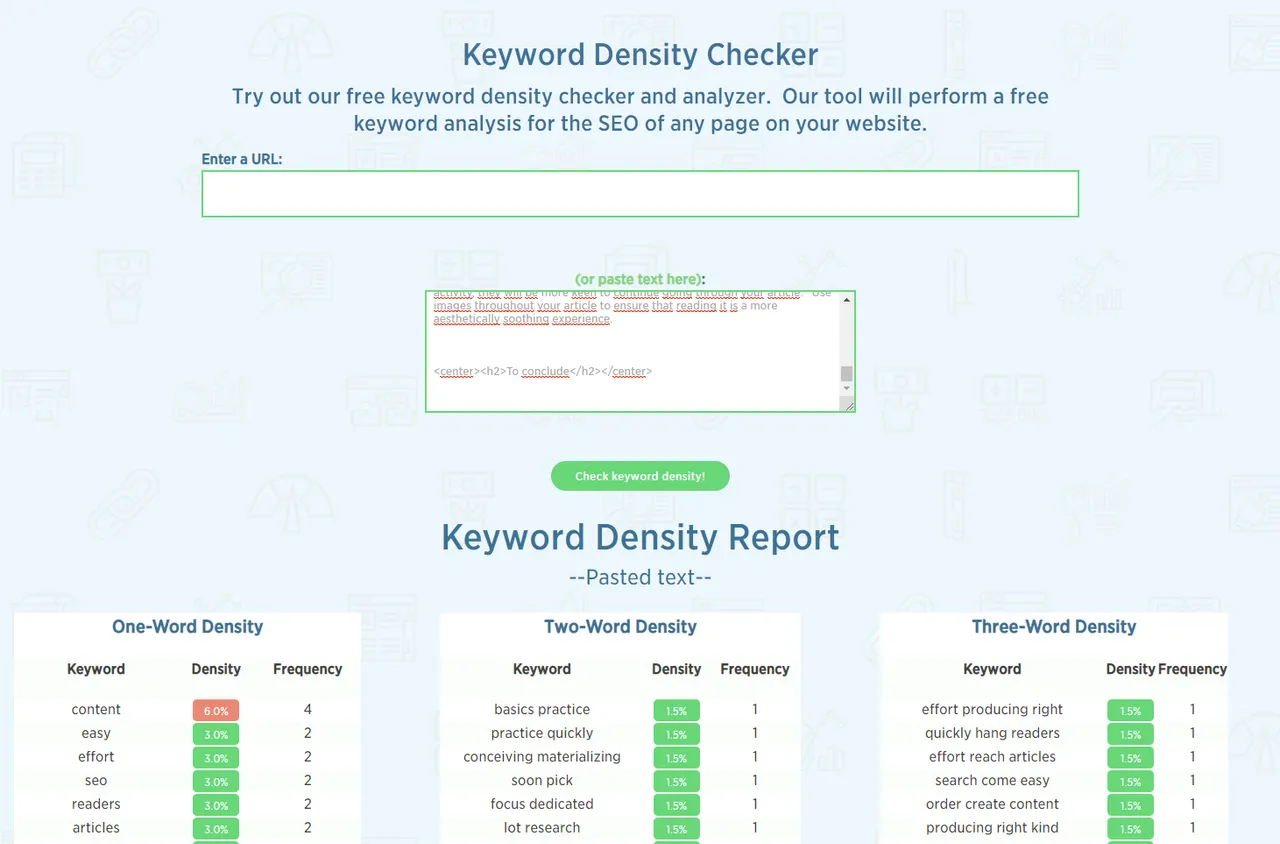
KeyWordDensityChecker will save you a lot of time as you won't have to do this manually. Just paste the text or link of your article into the search bar and it will instantly show you exactly which keywords you've mentioned too often.
Remember, anything over 5% is considered excessive.
#4 Write eye-catching headlines

Way too many writers overlook headlines.
After spending countless hours thinking about and creating a killer article, writers often tag on a mediocre headline just to finally wrap things up and publish. No bueno, because 80% of readers never make it past the headline so constructing an eye-catching headline should be top priority. You don't want to be spending all that time on writing to have it all go to waste because only a few readers click through your ordinary, dull, headline.
A headline can make or break your article, so let's learn how to not break it.
According to moz headline research there are five hig-level headline types:
Normal (Ways to Make Drinking Tea More Delightful)
Question (What are Ways to Make Drinking Tea More Delightful?)
How to (How to Make Drinking Tea More Delightful)
Number (30 Ways To Make Drinking Tea More Delightful)
Reader-Addressing (Ways You Need to Make Drinking Tea More Delightful)
Reader headline preference is the following:
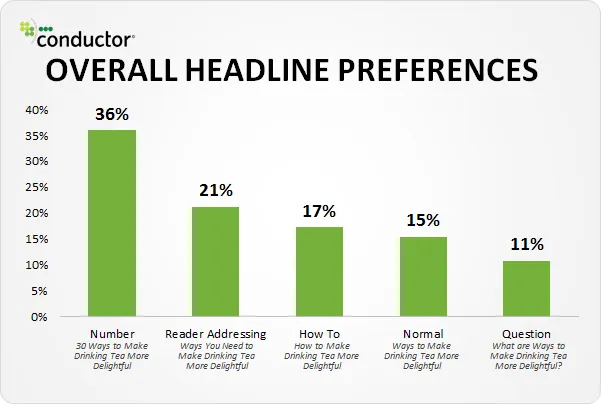
- 36% of respondents preferred headlines with numbers while
- 21% prefered headlines advertising them to do an action
- 17% decided to click on headlines including "how to"
- 15% pick normal headlines
- 11% rather go for headlines containing a question
A considerable difference is noticable, weighing in favor of "4. Number" and " 5. Reader-advertising" headlines. These are the type of headlines I'd advise you to to use when writing a SEO-friendly articles.
What about superlatives?
Moz tested a set of five headlines containing from 0 to 4 superlatives
- The 27 Ways to Train a Dog (0 superlatives)
- The 27 Best Ways to Train a Dog (1 superlatives)
- The 27 Best Ways Ever to Train a Dog (2 superlatives)
- The 27 Best Ways Ever to Train a Perfect Dog (3 superlatives)
- The 27 Best and Smartest Ways Ever to Train a Perfect Dog (4 superlatives
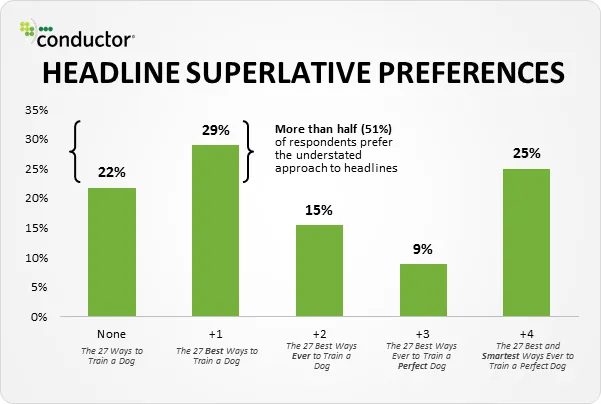
Readers either love or hate superlatives. They chose to click either on articles containing zero to one superlative, or on articles containing way too many superlatives. I seriously can't fathom why some people chose to click on titles containing so many superlatives. Personally, it immediately sounds scammy, fake, dishonest, clickbaity. It must be the older generation who are still falling for this fairly old trick.
They are definitely not our target audience so let's stick to using a maximum of one superlative.
To increase your click-through-rate don't over-use superlatives.
Finally, to conclude a great headline, let's see what's the optimal capital letter placement
By analyzing results of the following headlines:
(Lowercase) The 5 steps to prepare for the impending zombie apocalypse (lower case)
(Capitals) THE 5 STEPS TO PREPARE FOR THE IMPENDING ZOMBIE APOCALYPSE (capitals)
(Sentence case) The 5 Steps to Prepare for the Impending Zombie Apocalypse (sentence case)
No preference
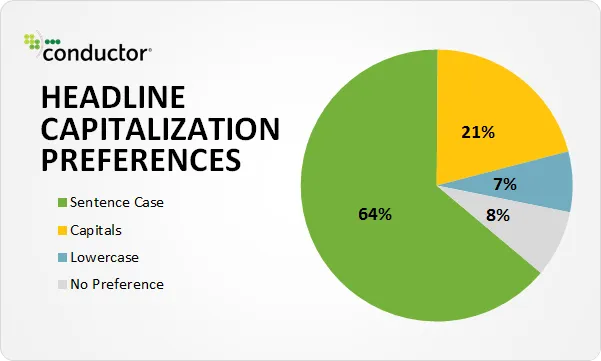
Moz concluded that the:
Best performing capital letter placement is (3. "Sentence case") or capitalizing the first word, first word of a subtitle, and all proper nouns. Interestingly enough, every fifth person doesn't mind being yelled at on the internet, choosing full-caps headlines first. I've had no clue about this before digging deeper into SEO recently but I've actually been capitalizing my headlines in such a way for a while now.
It's aesthetically superior to all other options and it works!
General tips for writing great headlines:
Be useful to the reader
Build a sence of urgency
Be very specific
Avoid ambiguity
Convey the idea that your article is unique
Write a headline that triggers strong emotions
Write only "number", "reader-adressing" and "how to" headlines for optimal results
Stick with "sentence case" or "full-caps" capitalization
Don't use more than one superlatives
Present a proposition that will instantly get your prospect interested to read more
But what if you've got no clue what to write as a headline?
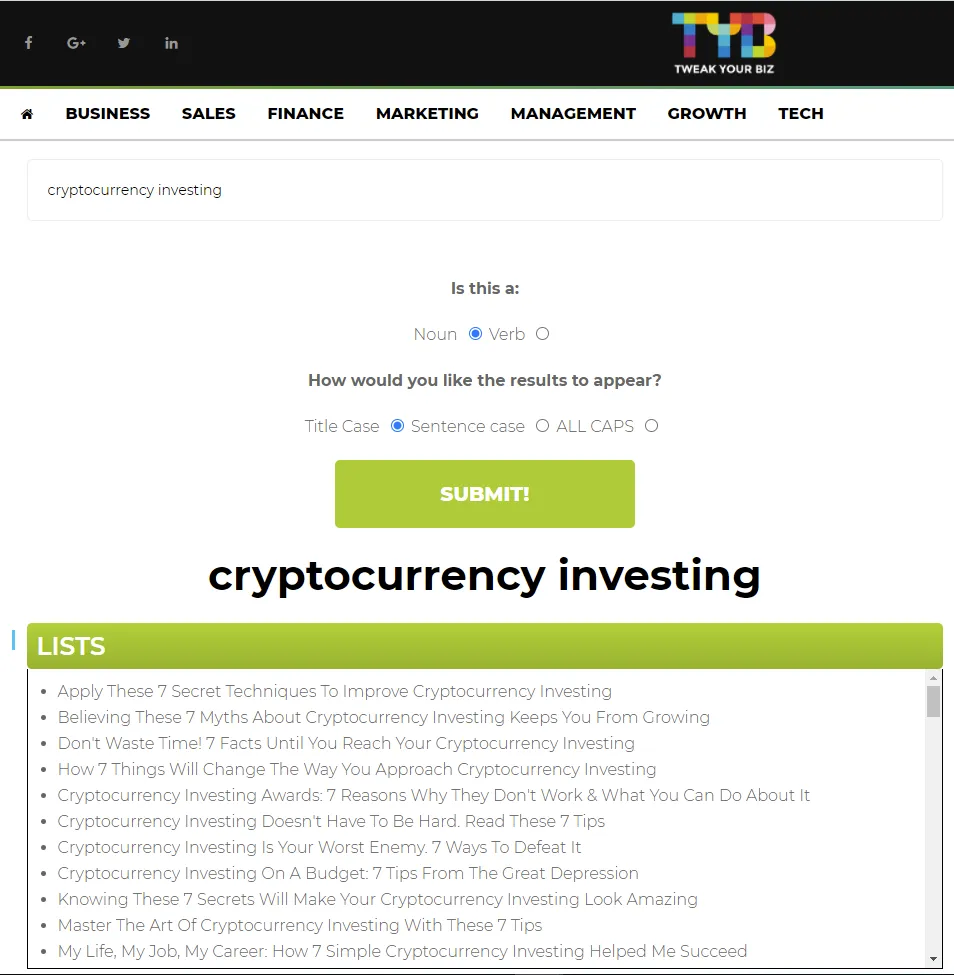
These tools will help you out.
If that's not enough to get your creative juices flowing I suggest reading:
- 40 Headlines: The Good, The Bad, and The Ugly
- 25 Headline Examples for Every Type You’ll Write
- 73 Easy Ways To Write A Headline That Will Reach Your Readers
#5 Structure and style our content to increase readability

The contents of your article may be amazing but readers can easily be lost in the words due to an unorganized, inefficient structure and style. Imagine you open up an article and it contains a single wall of text. How likely would you be to continue reading? You'd probably stop after the first few sentences and rightfully so. Reading through a continuous wall of text is extremely tiring and most readers will won't read through it, yet this is common practice on Hive.
Neatly structuring and styling your article is a key element that ensures an unineterupted flow from first sentence till the end. Elegant use of headings/subheadings, bite-sized paragraphs and cursive/bold can make a world of a difference in the numbers your publications yield. Breaking text up into bite-sized-chunks (smaller paragraphs with headlines) makes for an easy read that will keep your readers engaged until the end.
These are just a few ways writers can finalize their articles to make them easier on the eye and mind.
Title
Should be attractive, eye-catching, and magnetic.
Experts advise on keeping titles short. Up to five words and between 50 to 60 characters max.
People on Hive have a tendency to write excrutiatingly long titles. If you aren't able to let go of your bigg ass titles then just post your articles with a short title first and edit it afterward.
This way, you'll get to keep the massive titles while your URLs will remain the short version which is a big plus for your SEO.
Headings and subheadings
They should clearly summrize the paragraph below in such an irresistable way that readers have no chance but to keep reading. This will make your article look more professional and allow readers to quickly and easily scan through your text. Use headings and subheadings to captivate attention and structure your article in more digestible segments.
Best practice:
H1 to introduce the topic your rticle is all about
H2s to describe the main topics you’ll cover in sections of the article
H3 to H6s, for additional sub-headings within each section
Use headings as often as neccessary to separate large chunks of text into more managable pieces and to give additional context to a specific paragraph.
Paragraphs (KISS Keep it short and simple stupid)
Paragraphs shoudl be short and informative.
The more you are able to distill a complex idea into the shortest format possible, while still being able to coherently explain it, the better. The rule of thumb is to try using the least amount of words possible. This way you are going to be more successful in capturing and retaining readers attention throughout the article.
First paragraph is very important.
You've only got a few seconds to capture attention and only one chance to leave a good first impression so make it count!
The first paragraph should contain a clear message of what your article is about so readers can instantly know what if it will help them on their quest for information. It is also a great place to let Google and other browsers know what your article is about by including keywords you want to rank for.
Failing to include keywords in the first paragraph could result in your article ranking poorly.
Cursive/bold
Can be used to accentuate a certain word or a phrase or in order to break the monotony of plain text. Although they don't have a big impact on ranking, they certainly have a major influence on the readability and flow of your article so use them wisely. The rule of thumb is to use bold and cursive where further emphasis is needed and/or when they improve the aesthetic of a given sentence or paragraph.
Images/infographics/gifs/videos
Are great addition that give further context to a piece of text and allows readers to take a break from, well, reading. After a quick low brain-load activity, they will be keener to continue going through your article. Use images throughout your article to ensure that reading it is a more aesthetically soothing experience.

#1 Be strategic about our content
#2 Create evergreen, comprehensive, and useful content
#3 Make good use of keywords
#4 Write eye-catching headlines
#5 Structure and style our content to increase readability
While it may not be easy at first, writing specifically for SEO will launch your blogging career to the next level. Simultaneously it will greatly benefit both your personal blog and the platforms you publish on.
For SEO purposes, we need to step away from generalized and instead write specialized articles that will be directly searched for by potential prospects. Specific topic, question, or problem is what we want to be addressing as being useful to our readers is (among other things) how we get search engines to rank our articles higher. We should aim at writing unique, evergreen pieces as they keep pulling in views year after year. Wisely placing keywords throughout our articles is a must and so is writing magnetic, eye-catching headlines.
Last but definitely not least, structuring and styling our articles to perfection is another must if we want our articles to rank high. Keep paragraphs short and impactful. Use images, gifs, videos, quotes, headings, and subheadings to separate large chunks of text into more manageable sections, ensuring an easy and enjoyable read.
Tools
- UberSuggest
- BuzzSumo
- AnswerThePublic
- GoogleTrends
- WordTracker
- KeywordDensityChecker
- BlogTittleGenerator
- TitleGenerator
More info
- 44 Free Tools to Help You Find What People Search For
- The Beginner’s Guide to Evergreen Content
- How to Write Evergreen Content: All You Need To Know
- 40 Headlines: The Good, The Bad, and The Ugly
- 25 Headline Examples for Every Type of Content You’ll Write
- 73 Easy Ways To Write A Headline That Will Reach Your Readers
- 12 Writing and Formatting Tactics That’ll Get Your Longest Posts Read
If you've got this far congratulations, you are a true champ!
Assuming that you are interested in creating specialized, SEO content for your Hive blog, I'd like to invite you to join the Hive SEO enthusiast community and start posting. As far as I understand there are no restrictions on the topics you can write about as long as you are following SEO rules and principles. I'll keep a close eye on this community to curate and occasionally even hand out donations for those who put in the most effort into their creations.
